School Uniform Statistics: Cost, Safety, and Facts (2025)

Established nearly 30 years ago, school uniform policies have become increasingly prevalent over the years. During the 1995–1996 school year, only 3% of public schools in the U.S. required uniforms, this figure has surged to 19% now. Private schools exhibit even higher rates of uniform mandates, with 57% requiring students to adhere to uniform regulations.
This post combines the latest insights into the uniforms market as of 2025. We have data on student behavior with and without uniforms. Opinions of teachers, parents and students on the uniform policies and more.
Top School Uniform Statistics In 2025
- 18.8% of Public schools and 57% of Private schools in the United States need their students to wear school uniforms.
- 22 states authorize schools and districts to implement school uniform policies
- The cost of a uniform per child per year can range anywhere between somewhere between $25 to $500.
- School uniforms for girls are 12% costlier than boys.
- 38% of schools prefer blue in their school uniforms.
The History of School Uniforms
School uniforms have been around for nearly 450 years. Let’s look at why they emerged, how they spread, and what they represent in different cultures.
The earliest known use of school uniforms dates back to 1552 at Christ’s Hospital in London, a school founded for poor children. These uniforms were intentionally designed to be humble, durable, and standardized. A long blue coat and yellow stockings that still exist in a modernized version today. It was a statement of equality in a highly class-divided society abc then. The idea was to eliminate visible signs of poverty, giving every child a chance to belong, no matter their background.
In the image below, the right picture shows the very first version of Christ’s Hospial uniform in 1552 and on the left is the uniform of current times.
But It wasn’t until the Industrial Revolution and the rise of state-run education systems in the 19th century that uniforms started becoming common in Britain. As society grew more structured, so did education.
Then came the global expansion of school uniforms, not by organic growth, but through colonial influence. Countries like India, Nigeria, South Africa, and Malaysia didn’t traditionally have school uniforms. But as British-style schooling systems were introduced during colonization, so were uniforms. In many places, uniforms became symbols of modernity, progress, and access to a Western education, even if they were also reminders of colonial rule.
In Japan, the story is completely different. Uniforms were introduced in the late 19th century during the Meiji era, as part of a push to modernize and westernize after centuries of isolation. But the Japanese didn’t just copy the British model, they blended it with their own cultural values. The result? Uniforms like the sailor suit (seifuku) became cultural icons, deeply tied to youth identity, discipline, and even anime pop culture.
In contrast, the United States long resisted school uniforms. Until the late 20th century, uniforms were mostly seen in Catholic and private schools. It wasn’t until gang violence and dress code conflicts became major issues in the 1980s and ’90s that some public schools turned to uniforms, not for tradition, but for safety and cohesion. Even then, the debate about whether they help or harm individuality has continued. Only about 3% of public schools in the U.S. required uniforms in schooling year 1995-96. But that number has grown to 20% by 2025.
So yes, school uniforms have been around for nearly 500 years, but their meaning has never stayed the same.
18.8% of public schools in the United States require students to wear uniforms
According to official government sources, 18.8% of Public Schools in the United States require their students to wear uniforms. That’s 18,018 schools in the country.
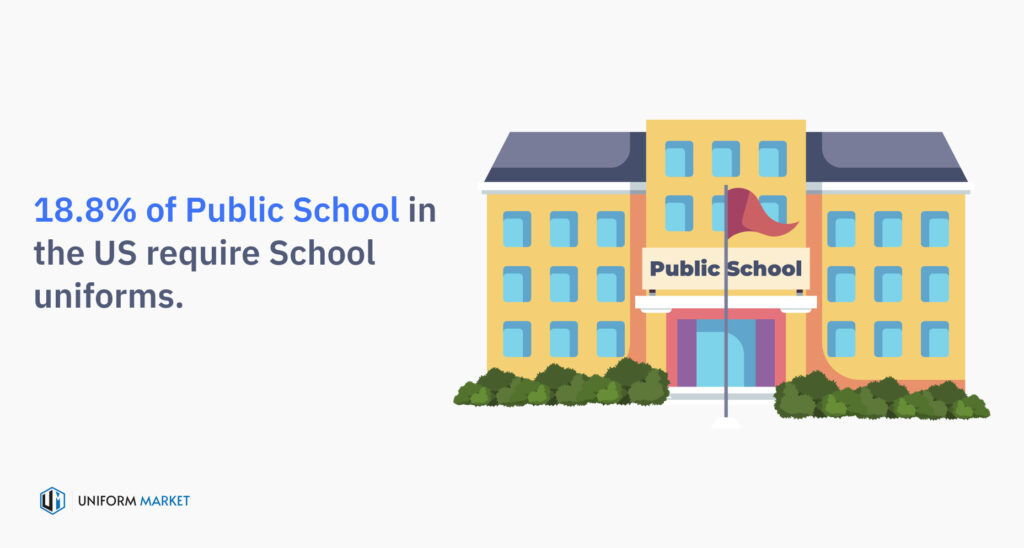
The share of schools that needed their students to wear uniforms increased by 0.9% in 2017-18 compared to the 2009-10.
| Year | Share of schools requiring to wear uniform |
|---|---|
| 2009-10 | 18.9% |
| 2017-18 | 19.8% |
| 2019-20 | 18.8% |
Source: NCES, MDR Education.
57% of Private Schools in the US require uniforms
57% of private schools in the United States have a school uniform policy. That’s 11,017 schools in total.
Among private institutions, 73% require uniforms when there are 500 to 999 students enrolled, whereas only 44% do so when enrollment is below 100.
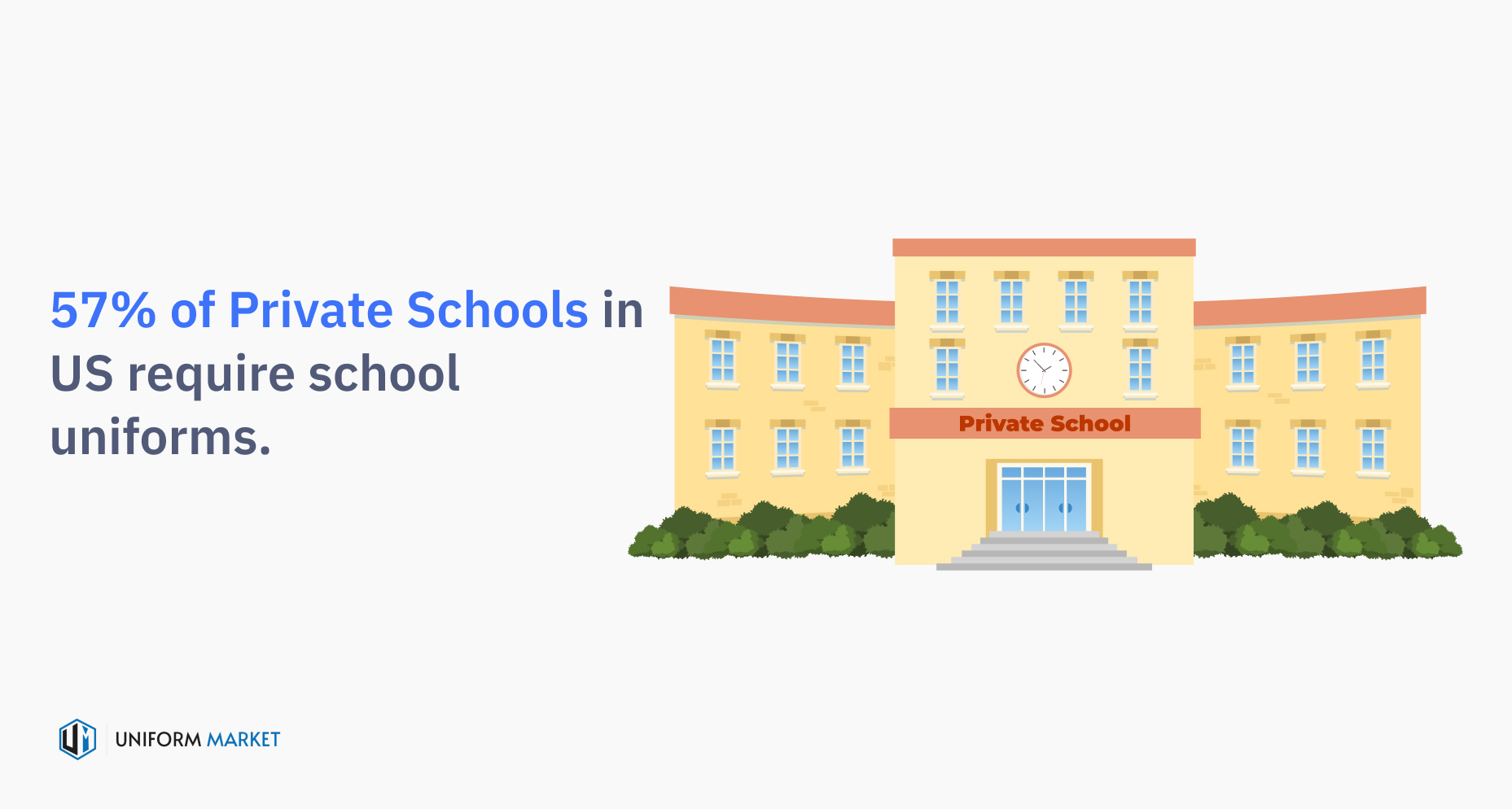
Source: NCBI, MDR Education.
Primary Schools require uniforms more than Middle and High Schools
What does this indicate? As students move from primary to middle and high school, they usually have fewer rules about wearing uniforms but stricter guidelines on what they can wear. This ensures everyone dresses appropriately, especially when uniforms aren’t required.
| School Type | Uniform Policies | Strict Dress Codes |
|---|---|---|
| Primary Schools | 23% | 43% |
| Middle Schools | 18% | 62% |
| High Schools | 10% | 56% |
22 states authorize schools and districts to implement school uniform policies
There are many states that have opted out entirely. Currently, only 21 states and the District of Columbia have formal school uniform policies.
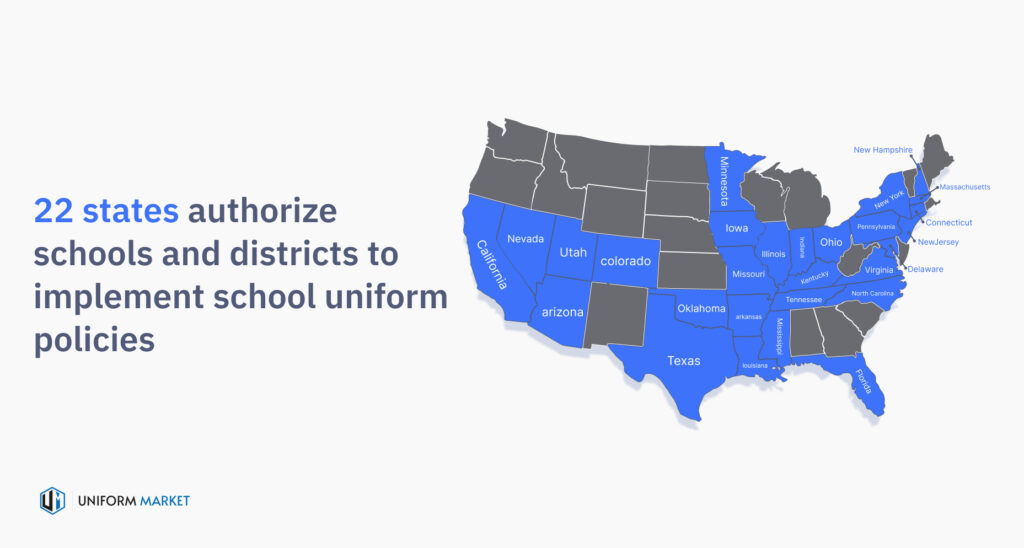
How much does the average uniform cost
In the United States, The cost of a uniform per child per year can range anywhere between somewhere between $25 to $500.
The cost of a standard uniform, which mainly consists of a top, trousers or skirt, socks, and shoes — ranges from $25 to $200. However, school-specific uniforms are generally costlier, typically ranging from $100 to $500.
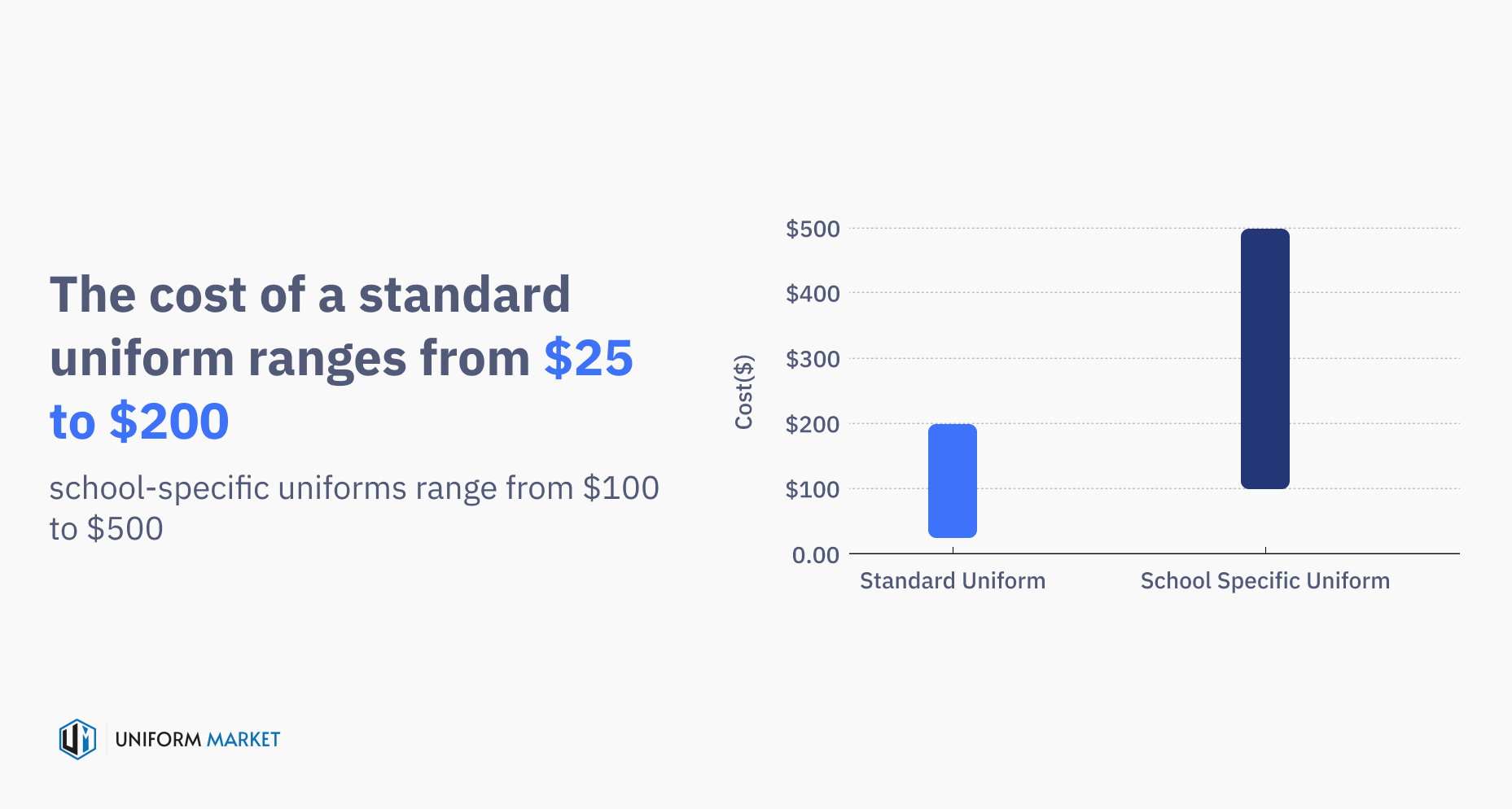
School Uniform Demographics in the United States
Schools with uniform policies tend to serve a higher proportion of Black and Hispanic students, with 20% Black and 40% Hispanic children enrolled. These schools also have a larger percentage of English Language Learners, at 27%.
Moreover, schools with uniforms cater to a significant share of low-income families, with 52% of their students coming from economically disadvantaged backgrounds.
Conversely, schools without uniform policies predominantly serve White children, with 64% of the students being White compared to just 31% in schools with uniforms. These schools also have fewer Black and Hispanic students (8–18%) and a smaller percentage of English Language Learners (8–18%).
Coming to income levels, schools without uniforms have a lower proportion of low-income students, at 41%, compared to those with uniform policies.
The average cost of School Uniforms in Australia
Australian parents spend about $330 on average for their child’s primary school uniform that suits both summer and winter, plus a sports uniform. For secondary school students, this cost increases to around $526 per student. Catholic and independent school uniforms are generally costlier than those for government schools.
The gender price gap in School uniforms
A study by Income Tax UK found that school uniforms for girls are priced, 11.9% higher on average than those for boys across major supermarkets like Tesco, Asda, Sainsbury’s, and Marks and Spencer. This difference, known as the “pink tax,” is observed in various sectors beyond the school uniforms market.
Over 12 years of school, this really adds up in terms of spending.
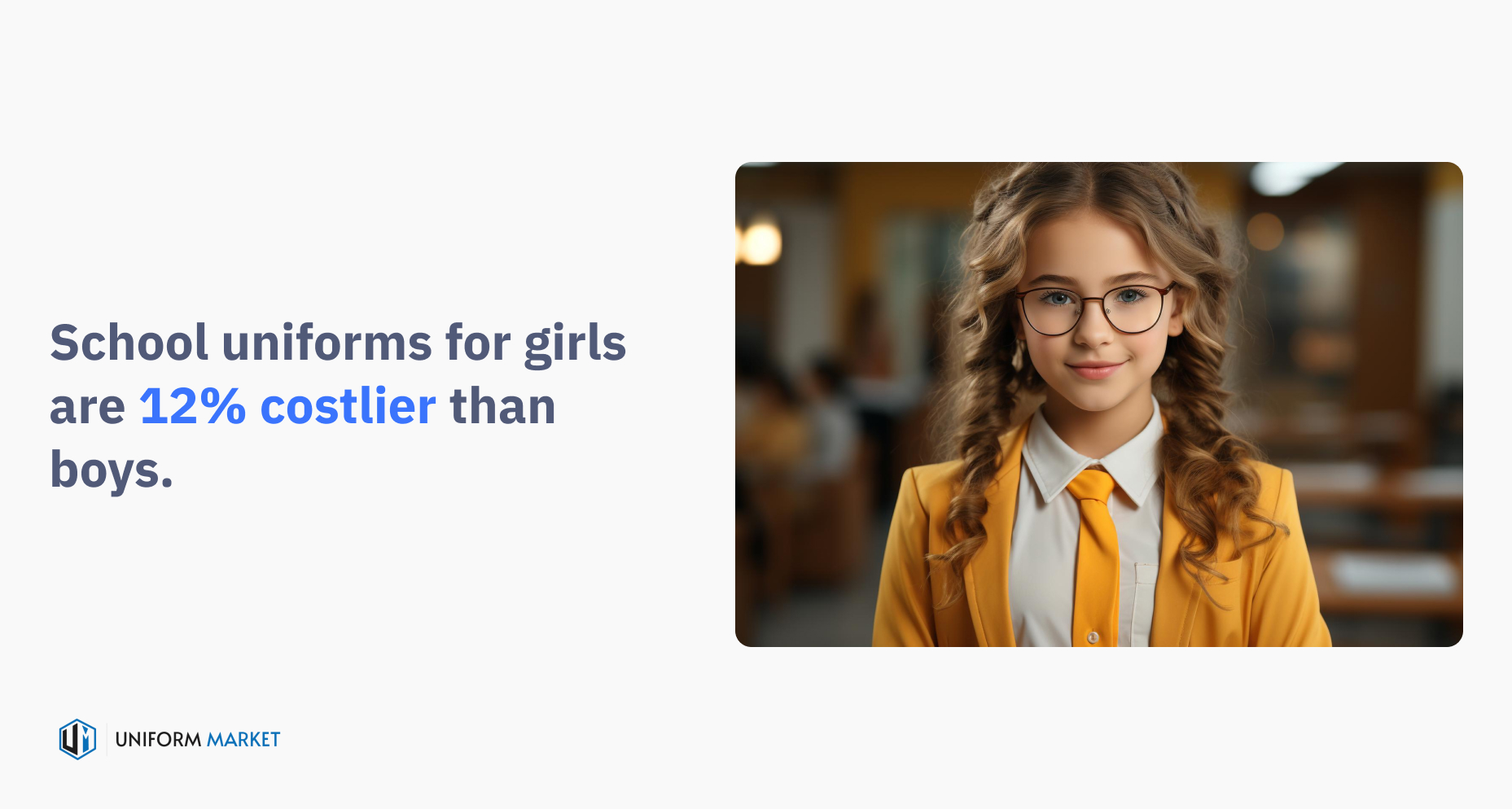
The school uniforms market size is $29.98 billion
The School Uniforms market is valued at $29.98 billion as of 2025.
After experiencing hiccups in the COVID-19 phase when all the schools were closed, the school uniforms market started to recover as schools reopened in late 2021.
The market is projected to grow at a CAGR of 7.3% till 2026 and reach a valuation of $32.32 billion.
| Year | Market Size |
|---|---|
| 2019 | $19.63 billion |
| 2020 | $21.07 billion |
| 2021 | $22.6 billion |
| 2022 | $24.25 billion |
| 2023 | $26.03 billion |
| 2024 | $27.93 billion |
| 2025 | $29.98 billion |
| 2026* | $32.32 billion |
Shades of blue are the most preferred for school uniforms.
38% of schools prefer blue in their school uniforms while white and red are preferred by 23% and 15% respectively.
Grey is not found to be prevalent in the United States. However, grey is a widely used color for school uniforms in England.
School Uniforms affect the much needed physical activity that students need
A study from the University of Cambridge looked at over 1 million kids in 135 countries and found that in places where most students wear school uniforms, fewer children are getting the recommended 60 minutes of physical activity each day.
This is especially true for girls, who are less likely to meet the activity goal, possibly because they feel less comfortable playing actively in skirts.
The study also found out that 16% of kids met recommended activity levels in countries where school uniforms were common, compared to 19.5% where uniforms were rare. Boys were 1.5 times more likely than girls overall, with the gap widening from 5.5% to 9.8% in uniform versus non-uniform countries, respectively.
Sports uniforms can reduce overall uniform costs and increase the level of activity among students
Switching to a policy where students wear sports uniforms every day can lead to significant savings. Parents would only need to buy a sports uniform, potentially saving about $167 for primary school students and $363 for secondary school students
Many students believe wearing sports uniforms every day would increase their physical activity, especially older students who are less active overall. About 9 out of 10
Switching to a policy where students wear sports uniforms every day can lead to significant savings. Parents would only need to buy a sports uniform, potentially saving about $167 for primary school students and $363 for secondary school students
Many students believe wearing sports uniforms every day would increase their physical activity, especially older students who are less active overall. About 9 out of 10 parents agree that school uniforms should encourage physical activity.
Views on School uniforms (Students / Parents / Teachers)
There are mixed opinions about uniforms among students, parents, and teachers, mostly inclined toward the unfavorable side. Let’s take a look at the findings from different studies.
90% of middle school students do not like wearing uniforms to school
In a survey conducted by the University of Nevada, Reno, among 1,848 middle school students, the results showed that 90% disliked wearing uniforms to school. Fewer students, around 30%, believed that uniforms could potentially reduce discipline problems.
Only 17% felt that wearing uniforms helped them concentrate better in school. About a third of the students, 34%, thought uniforms made their school safer, and 37% said they worried less about their appearance due to the uniform requirement.
52% of students, parents, and teachers strongly dislike the current uniform policy
The survey conducted in Richmond County about the school dress code revealed widespread dissatisfaction with the current policy. Out of 1,634 respondents, which included parents, students, and teachers, 52% strongly dislike the policy, while an additional 20% expressed that they simply don’t like it. Only 8.6% of those surveyed said they actually like the policy as it stands. About 12.7% indicated they don’t mind it.
A substantial number of employees (58%) and a large majority of parents (over 76%) disagree with how the policy is currently being enforced.
Schools with uniforms have fewer problematic student behavior
Schools that did not enforce uniform policies experienced more frequent student behavior issues compared to schools that did. Specifically, schools without uniforms had significantly higher averages of problems related to firearms and drugs than schools that implemented uniform policies.
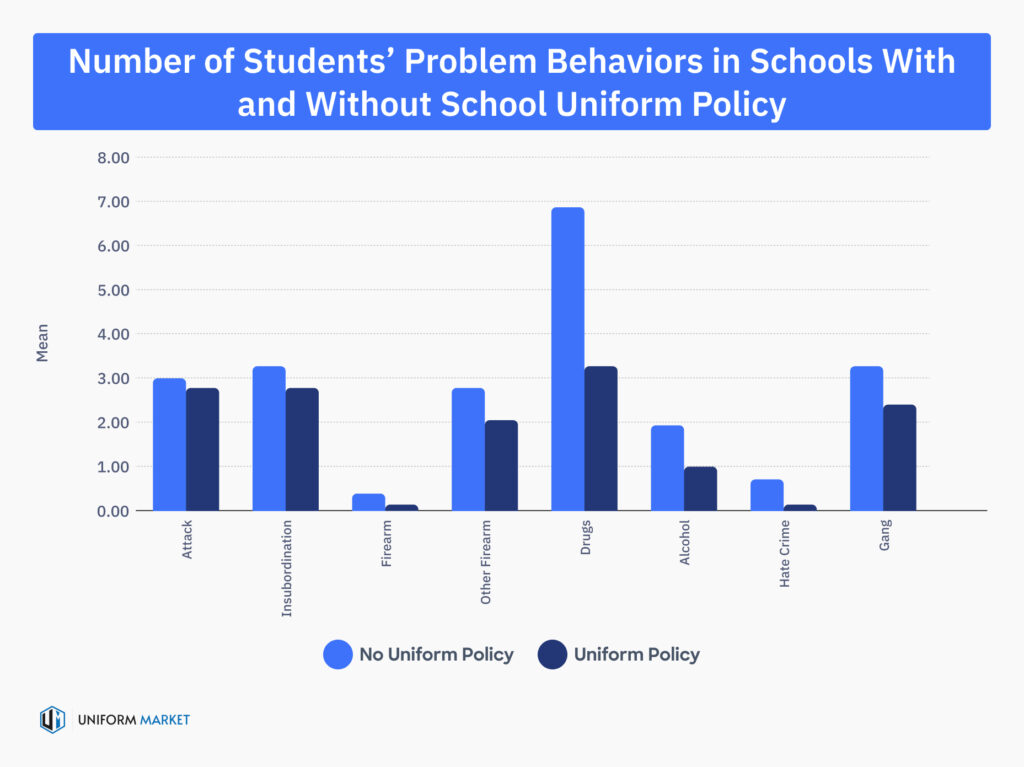
More than half (54.9%) of schools that did not require uniforms reported at least one weapon-related incident, whereas fewer schools with uniform policies (38.9%) had such incidents. Specifically, firearm-related incidents occurred in 19.5% of schools without uniforms compared to 7.6% in schools with uniforms.
Drug-related incidents were also higher in schools without uniforms (58.5% versus 43.1%), as were alcohol-related incidents (35.0% versus 16.7%) and gang problems (29.6% versus 20.1%).
These statistics show that schools with uniform policies generally had fewer incidents related to weapons, drugs, alcohol, and gangs compared to schools without uniform policies.
Schools with a uniform policy have better attendance rate
Research conducted in elementary, middle, and high schools across Ohio, Virginia, and the southwestern United States shows that schools with uniforms generally have better attendance compared to those where uniforms are not required.
Implementing uniform policies reduced juvenile referrals by nearly 70%
A study of 64 elementary schools in Florida over five school years, found that implementing uniform policies reduced juvenile referrals by an average of 69% (from 1.28 to 0.39) and decreased violent incidents by 52% (from 88.04 to 42.06) compared to the period before uniforms were introduced.
School uniforms are associated with lesser gang involvement
A survey of 415 students and 83 teachers from six middle schools in a city to study the impact of uniform policies on gang issues revealed that schools with uniforms saw a noticeable decrease in perceived gang presence according to teachers.
PFAS usage in school uniforms
A recent study tested 72 children’s clothing items from Canada and the U.S. for PFAS, a group of synthetic chemicals often used for stain, water, and wrinkle resistance. Researchers found fluorine, a marker for PFAS, in about two-thirds of the tested items. Notably, all 26 stain-resistant school uniforms contained PFAS, with 73% showing levels above 1,000 parts per million, indicating intentional use.
Further analysis detected 49 specific PFAS chemicals, even in items that didn’t initially test positive for fluorine. School uniforms had the highest median fluorine levels, particularly those made of cotton, which likely required more chemical treatment. The study also noted that uniforms, worn against the skin for long hours, pose a greater risk of exposure compared to outerwear.
Source: Chemical Institute of Canada
Answering Some Frequently Asked Questions About School Uniforms
How expensive are school uniforms?
School uniform costs can vary significantly, ranging from $25 to $500 per child annually. School-specific uniforms are typically more expensive, with prices between $100 and $500. Additionally, uniforms for girls are about 12% costlier than those for boys.
Do public schools have uniforms?
While most public schools in the U.S. do not require uniforms, the number of implementing uniform policies has grown over time. In the 1995–1996 school year, only 3% of public schools required uniforms. Today, this figure has increased to 18.8%.
What percentage of schools wear uniforms in the world?
It’s difficult to give an exact number, as the requirement for school uniforms varies depending on the country and even specific regions or schools within a country. However, approximately 60-70 countries worldwide have mandatory school uniform policies, especially in places like the UK, Japan, India, and many African and Asian countries.
This number includes countries where uniforms are compulsory in public schools, and it may fluctuate slightly based on local regulations or private school practices.
what percentage of schools wear uniforms in the world in 2024
36% of countries in the world have mandatory uniform policies while 39% of the countries have some sort of school uniform policies in place.
Having explored the key statistics and trends in the school uniform industry, you might be considering starting a uniform business. UniformMarket’s Uniform Management Software is here to help you turn that vision into reality. Whether you’re looking to streamline your inventory management, simplify the ordering process, or expand your business, our software is tailored to meet the unique demands of the school uniform industry. Contact us today to discover how we can support your journey to success!
Sports uniforms can reduce overall uniforms costs and increase the level of activity among students
Ready to launch your next
Employee Program?
Uniform Programs?
Company Stores?
Group Stores?
Team Stores?
Swag Stores?
Brand Stores?
Event Stores?
Distributor Portals?
Enabling uniforms and promotional product suppliers with eCommerce solutions to manage B2B, B2B2C, and Direct selling from one central platform.

